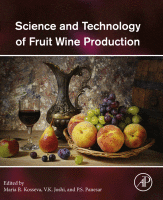Due to its tartness and bitter taste, bird cherry is rarely consumed fresh, the fruits are more used for compotes and jams. Another good option for processing berries is to make wine from bird cherry at home. The recipe for the drink is very simple, even novice winemakers can handle the preparation.
Only the most ripe juicy berries without mold, rot and signs of spoilage are suitable for wine. Another important point is the complete sterility of the containers used, otherwise pathogenic microorganisms will get into the wort, which will spoil the drink.
Ingredients:
- bird cherry berries – 5 kg;
- sugar – 1,5 kg;
- water – 5 liters;
- unwashed raisins – 100 grams.
Bird cherry wine recipe
1. Separate the berries from the twigs, remove spoiled, rotten and moldy fruits. It is advisable not to wash so that wild yeast remains.
2. Crush the bird cherry with clean hands or a wooden rolling pin, trying to crush each berry.
3. Mix 1 kg of sugar and 3 liters of water. Boil, simmer for 3-5 minutes over low heat, removing white foam. Cool the resulting syrup to 20-28°C.
4. In a container with a wide neck, mix the crushed bird cherry, chilled sugar syrup and raisins. Add 2 liters of water. Mix. Tie the neck with gauze to protect against flies, put the vessel in a warm (18-25°C) dark place for 2-3 days. Shake or stir once a day, knocking off the “cap” of pulp on the surface so that vinegar zones do not form.
5. If there are signs of fermentation (hissing, foam, slight smell of mash), drain the juice into another container, and squeeze the pulp through cheesecloth or thick cloth. Pour the liquid part into a container with drained juice. The squeezed pulp and peel can be added to sugar wash or discarded.
6. Install a water seal or a medical glove with a hole in the finger on the fermentation tank (fill up to a maximum of 75% of the volume) with juice. Move the bottle to a room with a temperature of 18-26°C and protect from direct sunlight.

After 5 days, add a second portion of sugar – 250 grams. To do this, drain separately 250 ml of wort, dilute sugar in it, pour the finished syrup back and close it with a water seal. After another 5 days, add a third portion of sugar – 250 grams according to the described technology.
7. Depending on the temperature and yeast activity, after 25-60 days the wort will brighten, sediment will appear at the bottom, the water seal will stop bubbling (the glove will deflate). This means that the young cherry wine is ready. It must be drained into another container, trying not to touch the sediment at the bottom. This is done through a thin tube lowered into the middle of the wine container.
If fermentation does not stop after 50 days from the start of preparation, so that bitterness does not appear, the wine should be drained from the sediment and put under a water seal to ferment.
8. Taste the drink. If it’s not sweet enough, you can add sugar. At this stage, sugar is no longer processed into alcohol, providing sweetness. Another option is to make fortified wine by adding 2-15% alcohol or vodka. Fixing promotes storage, but taste and smell change slightly.
9. Fill the holding tanks to the top so that there is no contact with oxygen. Close hermetically (if sweetening was done at the previous stage, keep under a water lock for the first 7-10 days), transfer to a dark cool place at 5-16°C and leave for 50-70 days for maturation, which will improve the taste.
Once every 20-30 days, when sediment appears at the bottom with a layer of 2-4 cm, filter the wine by pouring it into another container.
10. Cooking is complete when no more sediment appears. Wine can (optionally) be bottled and corked tightly. Store in refrigerator or basement.


It turns out black aromatic wine with a tart rich taste of berries. Shelf life – 2-3 years. Fortress – 10-12%.










